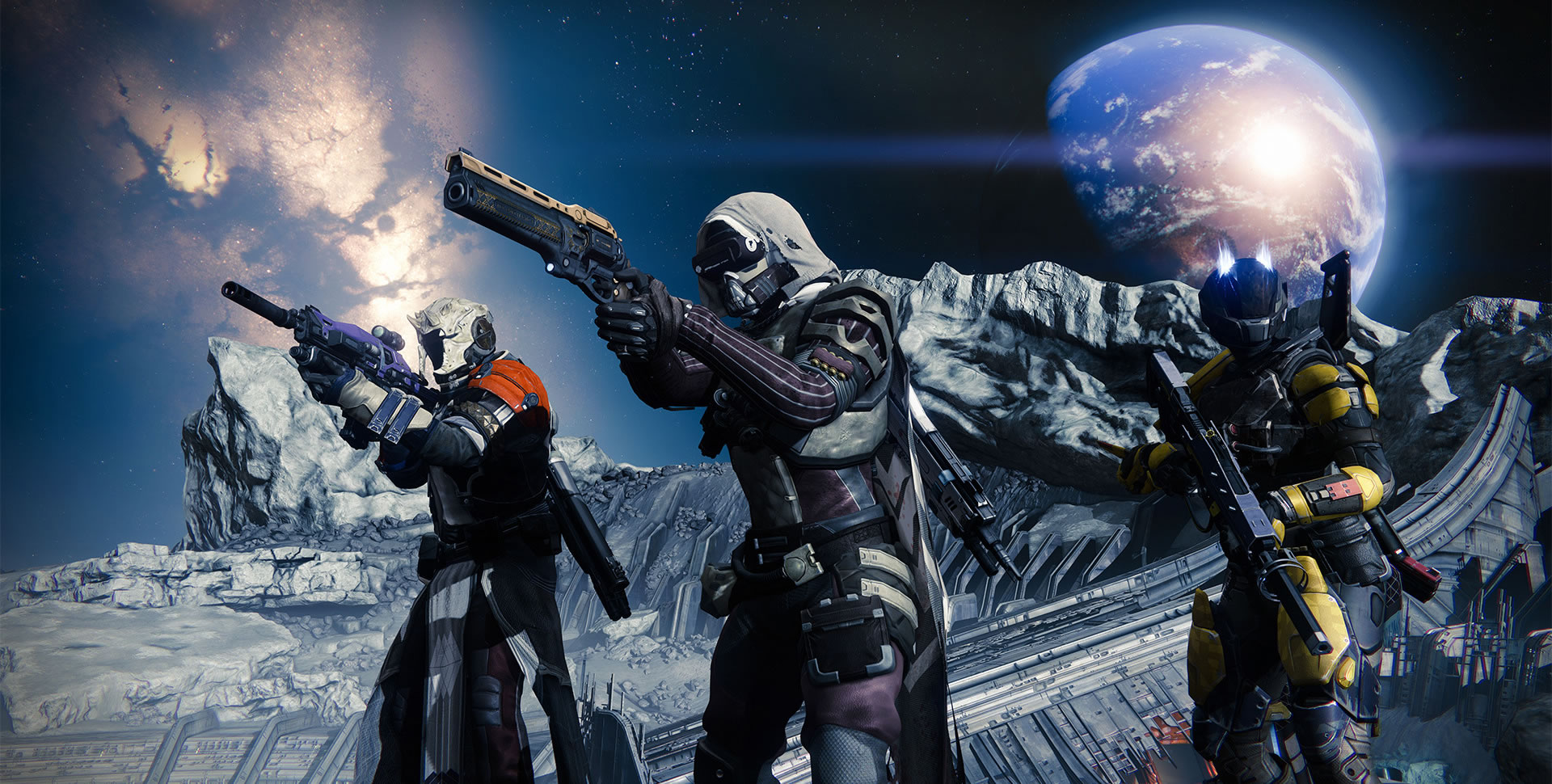
I'm sprinting across a battlefield alongside two friends. A massive alien gladiator wielding an equally massive shotgun chases us all over, his minions appearing on all sides. We shift and maneuver, coordinate our defensive strategy on the fly, cry out for help, rush to one another's aid. For twenty minutes we survive by the skin of our teeth, until the boss goes down in a tower of flame. We circle back to where he fell and start to dance. That's Destiny, too.
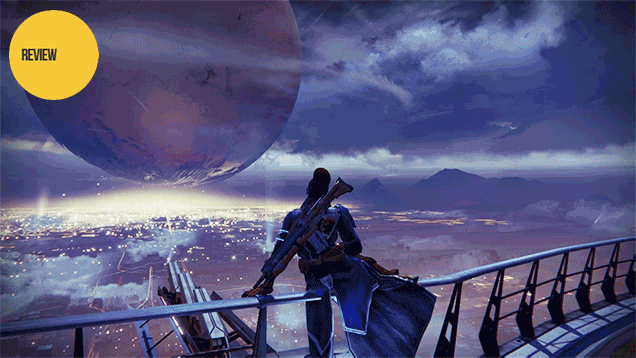
I'm urgently calling into the microphone to five teammates, frantically strategizing against a series of challenges that are so demanding and mysterious that we initially didn't have a clue how to proceed. I'm surprised to find myself more stiffly challenged by a video game than I have been in ages. We battle, we lose, we learn, and we regroup. We are becoming an increasingly well-oiled machine, split into squads, calling out positions to one another. Just when it feels like we're not going to make it, a moment of calm emerges from the chaos. Did we... Have we... Yes, we've survived to a new checkpoint. We begin to cheer---throaty, honest cheers, shared between relative strangers, filtered over a network from six different gaming headsets. That's Destiny, as well.
Destiny can be a cruel, exploitative game. It is deliberately unsurprising in so many ways, yet brilliantly bold in others. It's usually a lot of fun, except when it aggressively isn't. I can't stop playing.
Destiny is an always-online first-person shooter from Bungie, the studio that created Halo. It's set in our solar system, in the future, and puts you in the role of an anonymous Guardian, one of thousands of recently unfrozen action heroes. As you run around in the game, you'll see lots of other identical Guardians going about similar tasks, each one controlled by a player like you. Thanks in part to the game's popularity, there are always other people around. There's always shooting in the distance. You're no singular hero; you're one of many.
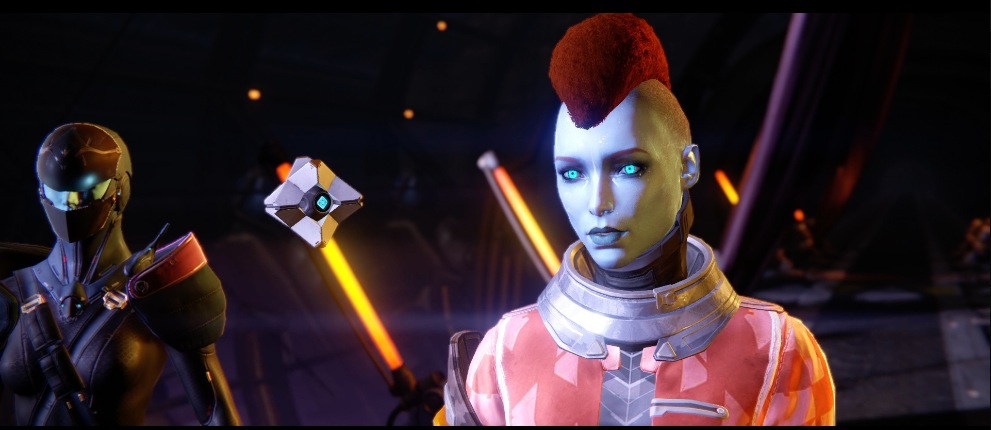
You've all been charged with going and shooting a bunch of aliens in order to help...save the world...or rather, help... well, it's not quite clear what you're really doing, actually. You're shooting things. That's pretty much what you're doing.
All that shooting is glued onto a character-leveling structure a la World of Warcraft. As you play, the game provides regular drips of experience points, which allow you to level up, which in turn grant you new powers (like, say, a double-jump or a black-hole grenade) and the ability to access more powerful weapons.
So that's what you do. Shoot enemies, get XP, and level up. Shoot more enemies, get more XP, and level up again. Once you hit level 20, you go and shoot enemies, get new gear, and use that gear to level up. That's pretty much all there is to it.
Let's get this out of the way up front. Should you play Destiny? Sure. Yeah. Totally.
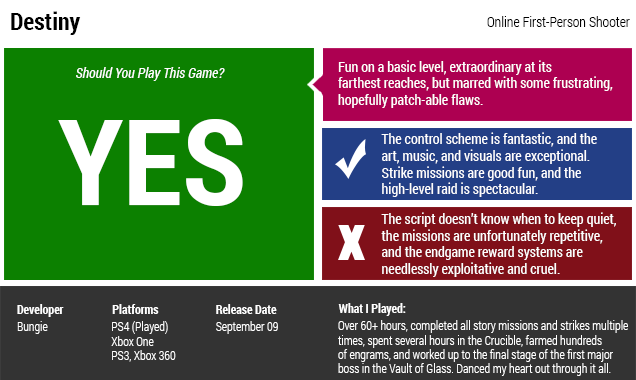
Be warned, however: To play Destiny is to willingly give yourself over to a machine, a machine terrifying in the slickness of its construction and the single-mindedness of its purpose. You may find yourself hating this game as much as you like it, and unable to stop playing nonetheless. Destiny coaxes players into a carefully-wrought network of rewards, roadblocks, checks, and balances, pushing them ever onward into more challenging arenas while slowly rewarding patience with experience points, new abilities, and new weapons.
Submit, the game demands. Submit and you will be rewarded.
Well, you will be rewarded if we feel like it.
When I think back to the 60+ hours I've spent with Destiny thus far, I generally think of all the ridiculous things I've done in an effort to get a leg up, some kind of leg up, on this massive, iron-clad machine. Sure, I completed the story missions, and I competed in the player-vs.-player "Crucible" matches. I've also spent hours running around the same field, shooting thousands of replicating enemies, hoping for an easy reward. In pursuit of an advantage, I have stood in front of a door and blown away hundreds of foes, letting myself be eviscerated only to rise, Groundhog Day-like, and blow them away again. And now, the Loot Cave.
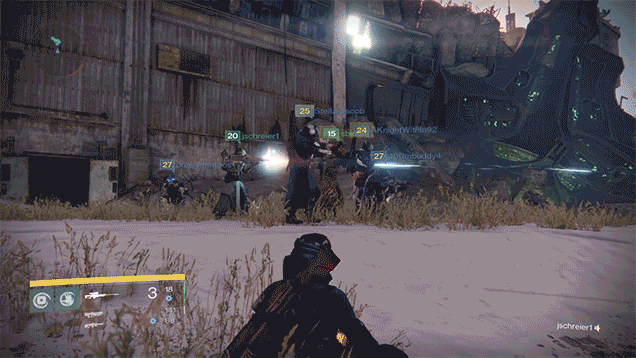
Here's how the Loot Cave works: The cave itself is located in one of the game's sizable open levels. You stand outside and shoot the enemies that come out of it. If you kill all the enemies before they can leave, the game spawns more of them, creating an essentially unbroken stream of cannon fodder for you. Since every enemy killed has a chance of dropping some sort of weapon or armor, in about a half an hour the cave will be covered in gleaming rewards.
Word of the Loot Cave spread fast, and if you visited the cave any time last weekend, you'd find a bunch of players sitting out there, mindlessly slaughtering the aliens inside it. Not just sometimes--- every time you passed the cave. How many players are standing there even as you read this, staring down a gun barrel into a cave, blithely pulling the trigger again, and again?
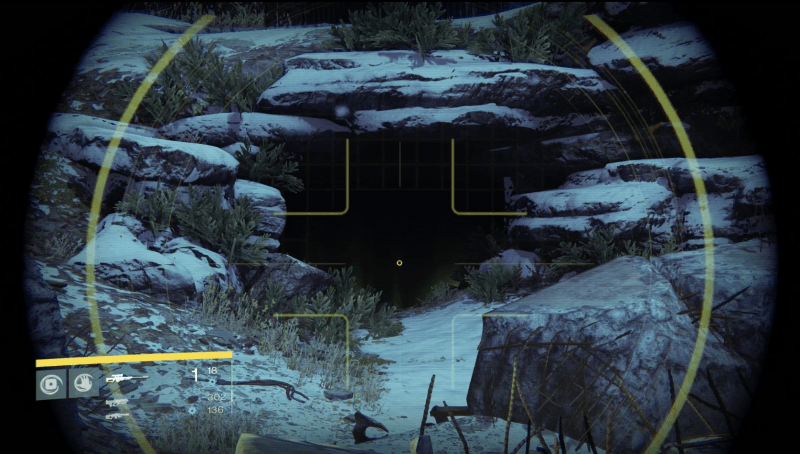
The Loot Cave is what's known as an exploit, a trick the game's developers didn't anticipate that allows players to bypass the game's carefully-scaffolded progression system and earn experience points and gear faster than the developers intended. That so many players would so eagerly latch onto an exploit like Destiny's Loot Cave only makes sense, given the game in question. Destiny itself is brazenly, almost inhumanly exploitative, so it's only natural that players would take every opportunity to exploit it right back.
Destiny has exceptionally strong fundamentals. That's good news, since many of its most evident flaws could, in theory, be addressed with a patch, while things that are more difficult to alter post-release---feel, controls, physics, audio---are solid as bedrock.
With Destiny, Bungie has created the most physically satisfying shooter control scheme since 2006's Gears of War. It's essentially a hybridization of the pinched, focused down-the-sights aiming popularized by Call of Duty and the more open, acrobatic shooting of Halo. Destiny's melee attacks, for example, fire off with a satisfying thwok, which makes the decision to move them from the thumbstick to the right shoulder button appear perfectly sensible. Everything is where it feels like it "should" be and works in concert with the game's design to effectively connect players to the action on screen.
Everything in Destiny moves with a slight heaviness, and the player's finger movements translate onto the screen with just a hint of a delay. That weightiness, combined with Destiny's 30 frames-per-second performance, makes the game feel more deliberate and substantial than most other first-person shooters. Timing and rhythm are everything: Each action stacks on the two or three actions before it, a significant change from the twitchier pace of Destiny's contemporaries.
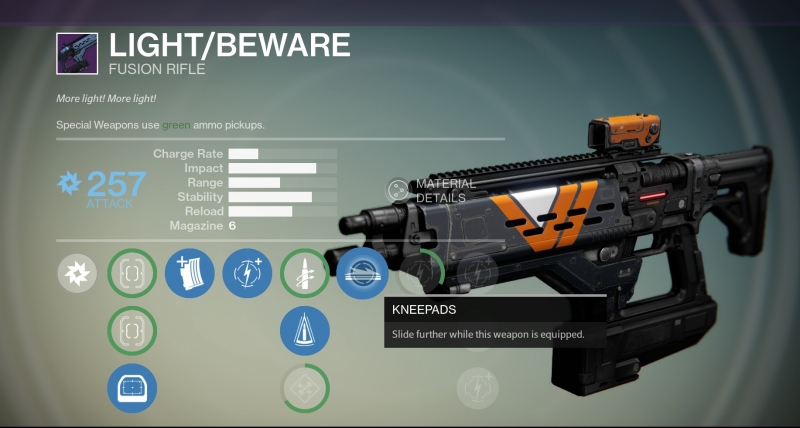
Weapons and abilities all react according to Destiny's particular internal tempo. The fusion rifle charges and fires at a broken pace, launching a barbed fusillade of projectiles after a brief moment of clogged buildup. Interacting with an object requires holding down a face-button while a small circle quickly fills around the on-screen prompt. My character has a drifting double-jump that allows me to press X once to leap, a second time to boost myself through the air, and a third time to cancel my boost and ride my momentum up and over whatever obstacle I'm attempting to bypass.
If I aim while in the air, I'll hover in place for a couple of seconds, just enough time to snap off a quick shot or two while slowly drifting along on my own momentum. It feels like flying, or somehow better than that---like leaping, falling, and somehow maintaining control. Enemy weapons fire projectiles that move through the air slowly enough to register and dodge, meaning that a skilled player can learn to sidestep enemy fire. With every firefight I leap, float, and weave my way through oncoming projectiles, pirouetting like a heavily-armored ballet dancer. This is lovely stuff.
Everywhere you look, Destiny displays technical and artistic mastery. The vistas are astonishing, conjuring if not the actual view from the surface of planets like Mars and Venus, then what our imaginations suggest those planets should look like. The soundtrack, written by a gaggle of composers led by Martin O'Donnell, Mike Salvatori and C Paul Johnson, is at times distractingly good, full of the sort of soaring, reach-for-the-stars orchestral stuff that video games almost never get. Creatures, costumes, and weapons are all wonderfully detailed and conceived. The "sparrow" speeder bikes are my favorite form of video game conveyance in years, and if humans ever do make a levitating motorcycle, I'll be disappointed if its engine doesn't match the sparrow's undulating whirr.
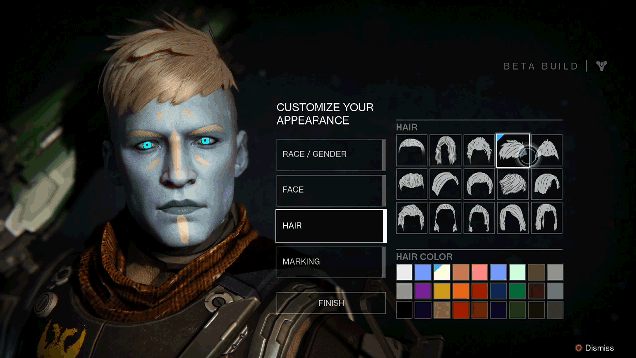
To top things off, Destiny features some of the best video game hair I've ever seen.
Unfortunately, that same level of craft was not applied to the game's narrative. (If only it had been! Argh!) Alas, Destiny's story uncomfortably straddles the fence between wisely keeping quiet and blithely saying far too much.
The game paints its broad narrative strokes well: A massive white sphere called The Traveler arrived on Earth some hundreds of years ago, bringing with it great technological advancements and setting mankind on course to a new golden age. Humans explored and colonized the rest of the solar system before The Traveler's nemesis, a vague power called The Darkness, arrived and destroyed most of civilization in a catastrophic war known as The Fall.
The player, a nameless Guardian, awakens at some point after The Fall and is tasked with setting out from Earth, re-exploring the ruins of civilization, and fighting back against The Darkness in order to save The Traveler.
Trope-laden though that may be, it's not a half-bad setup for a sci-fi story. The fine musical score props up otherwise goofy cutscenes, while the phenomenal art direction lends the wreckage on each of the game's four major planets an outsized, mournful beauty. Enemies are given discordant fantasy names, and while I initially raised my eyebrows at seeing aliens referred to as wizards and knights, the whole thing eventually begins to make a kind of sense. These strange robots are called hobgoblins, those beastly automatons are minotaurs. We don't quite know why they're called that, why there is a region on the Moon called "The Anchor of Light" or part of old Russia is known as "The Mothyards," but our imagination does a pretty good job of filling in the blanks.
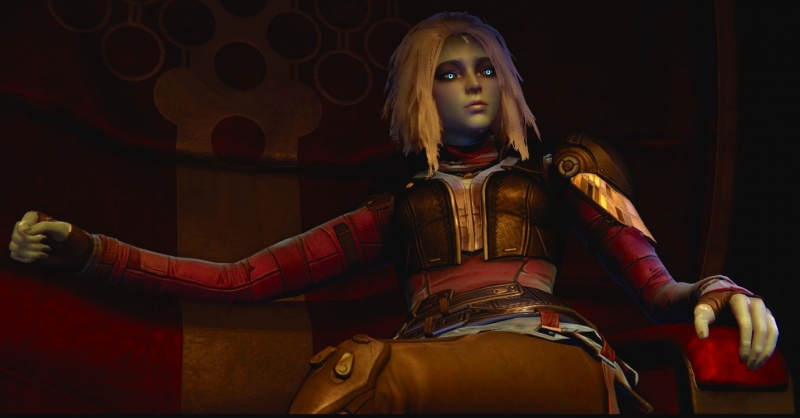
Critic Cameron Kunzelman calls that storytelling approach "the evocation effect." As you navigate these spaces, you don't spend too much time wondering why things are called what they are, why things look the way they do. Those things simply are, and in Destiny, they're largely convincing. Or, well...they're convincing until one of the game's characters starts talking and ruins everything.
Most times, the person talking is Peter Dinklage. Poor, poor Peter Dinklage. Best known for his scene-stealing performance as Tyrion Lannister on HBO's Game of Thrones, Dinklage plays Ghost, your little, flying robot friend and the unfortunate soul tasked with unraveling spool after spool of exposition in between battles. Much has already been made (by me, even) of Dinklage's flat, aimless performance. Yes, the responsibility for that is partly on the actor---after all, his co-stars Lance Reddick, Gina Torres, Nathan Fillion, and Bill Nighy may be wasted in their roles, but they do manage to make all that chewy lore sound convincing. But the script is the real problem here. ("The sword is close...I can feel its power," Dinklage intones. "Careful! Its power is dark.")
For all of the technical and artistic prowess Bungie brought to bear on Destiny, they appear to have been unable to employ a person or persons capable of writing a coherent story or believable dialogue. The single most famous line of dialogue from Destiny--- Dinklage's "That wizard came from the moon!"---is actually no longer in the game. It became a meme during the game's public alpha and was subsequently cut, as though it were a jarring lousy line in an otherwise decent script. The irony is that every other line in the game is just as bad as the moon-wizard line, if not worse. The best solution would probably have been to cut the majority of the game's dialogue altogether.
For those who care, a great deal more backstory is revealed via unlockable "grimoire cards" that can only be viewed in a browser on Bungie's website. I would have been happier if the bulk of Ghost's exposition had been relegated to those cards and the game itself had let me take it all in at my own pace.
I called Destiny a cruel game, and that's largely due to the way it hands out rewards. I may never have experienced a role-playing game this parsimonious with material rewards for players, and Destiny's feedback loop often hops the lane-divider from tight-fisted to perverse.
Let me try to explain: For the first fifteen or so hours, players will follow a traditional sort of role-playing game progression. Shoot bad guys, complete missions, get XP, level up, get new powers. But once the player hits level 20, he or she must begin to obtain and upgrade rare armor in order to earn further levels. Bungie has audaciously placed the game's first (terrific) six-player raid beyond a level 26 requirement, meaning that any player who wants to experience the game's most exciting and challenging content must first agree to earn six levels' worth of extremely rare gear and upgrade materials. If the raid is the carrot that provides much of the motivation for grinding through all those extra hours of repetitive (if generally enjoyable) combat, the loot system is all stick.
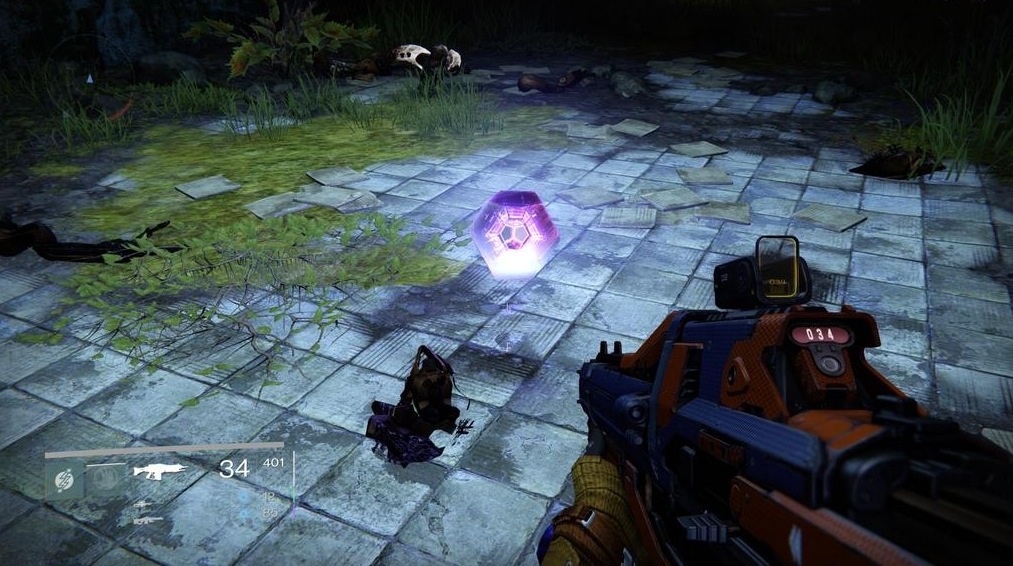
Here's how the abusive loot system works: A scant few enemies you shoot will drop a large dodecahedral(ish) gem called an "engram" that contains an item, sort of like a sci-fi Kinder Egg. After collecting an engram, you must take it to a special merchant in the game's town to have it decoded, which will reveal what sort of item it contains.
Engrams are coded to one of three different colors, which theoretically correspond to the rarity of the item contained within. There's green for uncommon, blue for rare, and purple for legendary. Almost every engram in the game is green; a few are blue; one in a hundred is purple. For most players past a certain point in the game, purple engrams are the only ones that are worth anything at all. So, seeing one pop out of the air after shooting an enemy sets off a rush in your brain, like spotting a $20 bill on the sidewalk.
Now we get to the cruel part: As it turns out, legendary engrams don't always give you legendary gear. I have gone to the decoder guy with four purple legendary engrams, only to walk away with three useless blue "rare" items and a rare piece of crafting material. On the off-chance that a purple engram does net you a legendary item, there's a 66 percent chance it'll be specific to another class and therefore still useless for your character.
FUCK EVERYTHING #PS4share pic.twitter.com/Ti3e7ljNIH
--- Brad Shoemaker (@bradshoemaker) September 20, 2014
I cannot fathom what motivated this design decision. Why on earth didn't Bungie make legendary engrams always grant legendary gear, then just make them drop less frequently? Did they want to create a dysfunctional relationship between their game and their players? Did they want their game's defining emotion to be resigned anger, to abuse us into distrusting their systems?
If so, they were successful. I no longer trust the excitement I feel at seeing a purple engram, because I no longer trust Destiny itself. Yet I get excited anyway, and before I know it I'm standing in front of that cave, shooting monsters and hoping for a jackpot. As it turns out, unhealthy game design begets unhealthy play.
Destiny's greatest failing, then, is that the activities that are the most rewarding for players aren't the same as the activities that are the most rewarding according to the game's stringent economy and arcane inner logic.
For example: Strike missions. Strike missions are some of the best stuff Destiny has to offer. Each of the game's six included strikes must be undertaken by a party of three, and as long as you play on the proper difficulty level, they're designed to be so challenging as to require teamwork and daring, aggressive play. Like every mission in Destiny, the structure is generally the same across the board: Go to a place, kill a bunch of tough enemies, fight one boss, go to another place and take on another, much harder boss.
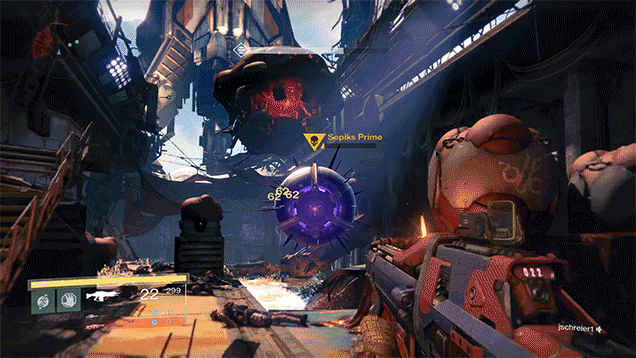
That's a reductive description, though, and it doesn't capture the enjoyable bedlam of a good strike. Each strike mission's final showdown feels impossible to master---you're never comfortable, never able to find a consistent strategy, always reacting and reviving and regrouping. There is some excellent level-design on display in these areas---wide open spaces with just enough cover and sneaky side routes to encourage improvisational play, all built to facilitate the deadly boss and its less-deadly minions as they push players around the room. I've replayed each of the game's strikes many times on various difficulty settings, and I've never once been bored.
But here's the thing: Strike missions don't actually "pay" all that well, according to Destiny's economy. By and large, the rewards they offer are inferior to the rewards that can be gained by repeatedly undertaking other more banal, boring tasks. For example, some strikes pay in a hard-to-acquire type of faction currency, but players can earn an equal amount of that currency doing a single one of the far less interesting, copy-paste "patrol" side missions available on each planet's surface. Other high-level strikes will earn the player rare crafting materials, but most of those materials can be earned in a commensurate amount of time by standing outside the Loot Cave.
At times, I've felt as though I'm playing Destiny "wrong" by farming exploits and choosing boring missions over enjoyable ones. But if I'm playing incorrectly, why has the game been designed to reward that style of play?
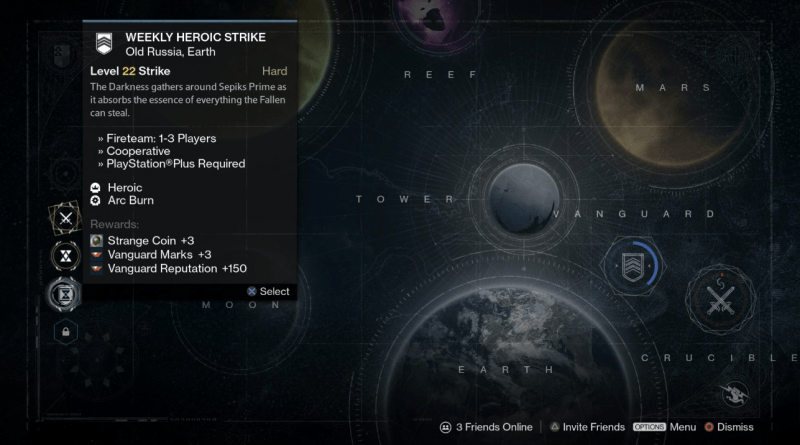
I float in my ship in between missions and ponder my next move. How shall I spend the next hour? I could undertake a high-level strike mission, probably have a hectic and fun time, and come away with a paltry reward for my trouble. Or I could spend the next hour standing at the Loot Cave, shooting into the slot machine and cashing in my rewards for much-needed currency.
The latter activity will yield better rewards over the same period of time, so why shouldn't I go and do that? If anything, that's playing Destiny the "right" way. One can only complete a thirty-minute raid with nothing to show for it so many times. It's only natural that players will eventually turn into the skid and claim their rewards by other means.
One remarkable thing about Destiny's mostly unremarkable player-vs.-player deathmatches is how well they're integrated into the fabric of the game as a whole. At any time you can take on up to eleven other players in The Crucible, which is portrayed as a sort of competitive training arena for Guardians to hone their skills before heading back into the world to fight real evil.
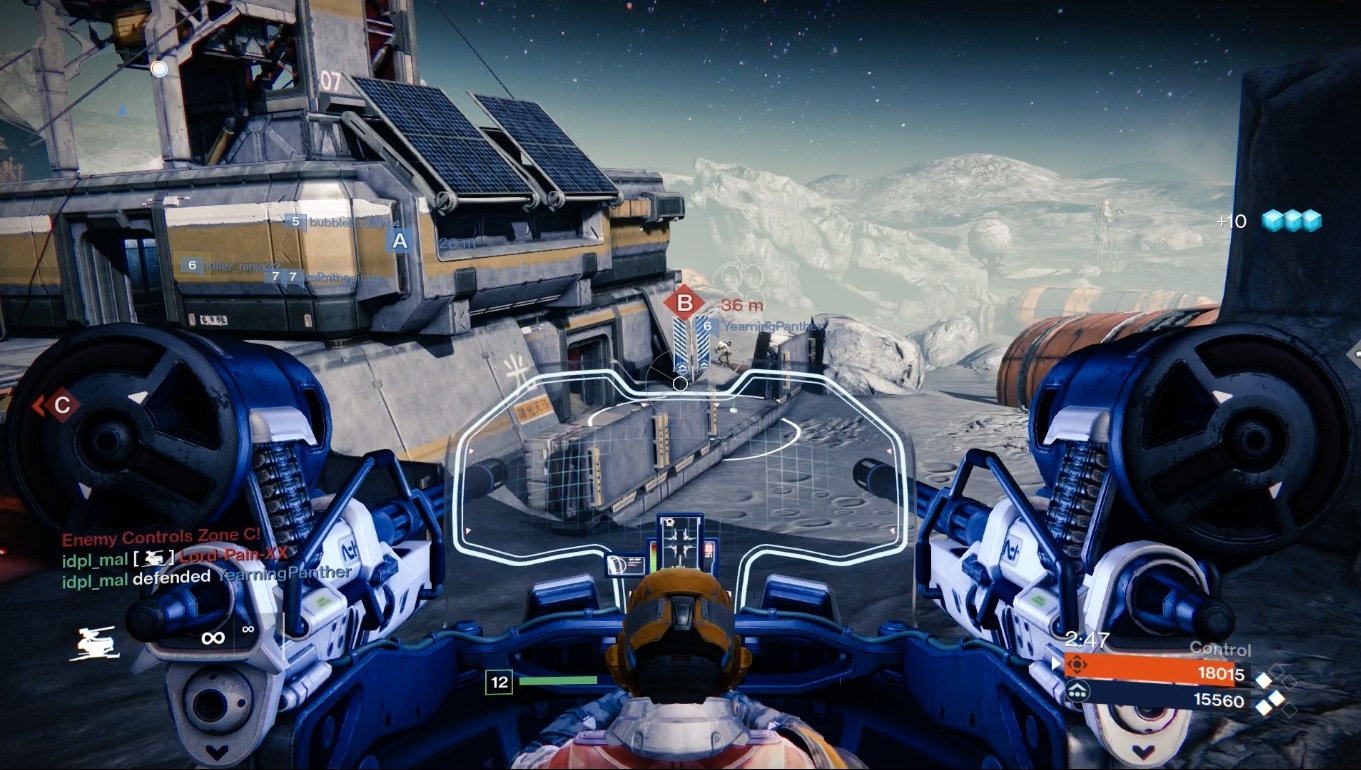
As it stands, the game includes only four basic PvP modes: team deathmatch, every-Guardian-for-themselves deathmatch, small-team deathmatch, and control-point domination. All of those are simple fun---the control point matches are generally the most enjoyable---but none are particularly exciting on their own. Bungie are old hands at competitive multiplayer, and while Destiny's battles bear some of the same hallmarks as Halo's best stuff---the varied, well-designed maps and a focus on verticality and agility over speed---they sorely lack that series' intricate customization options.
With each match of Destiny PvP, for now at least, what you got the first time is what you'll get next time. Each match cannot be altered in any way, and the various modes don't even offer private lobbies. Furthermore, while each player's damage and armor stats are leveled out to provide balance, players with high-level gear still enjoy bonuses like faster fire-rates and more exotic special abilities. I'm not quite sure how (or if) Bungie has balanced all of that out, but it certainly doesn't present the appearance of a level playing field.
The Crucible feels like an intro class in competitive multiplayer and only really works when viewed as a smaller part of the overall Destiny experience. It is, however, noteworthy how well the Crucible is folded into that overall experience. The Crucible can be accessed from the same map screen as every other mission, which makes it easy to casually drop in for a match or two, then pop out to get back to adventuring. You'll earn loot and experience in the Crucible that directly translates over to the co-op story stuff, and with time can trade currency earned in battle for high-level gear.
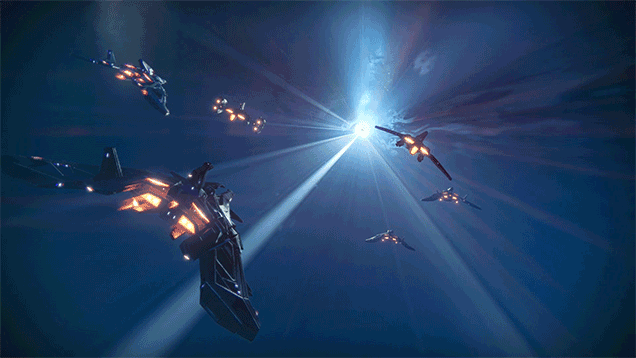
As you depart for a new Crucible match, your spaceship will be joined by the ships of the people you'll be fighting alongside. It's one of my favorite of Destiny's many small touches. Watching a flock of six spaceships speed toward a new arena is oddly charming, like watching six grade-school kids on their bicycles riding to the park to play cops and robbers. Be sure to come home before dark, Guardians!
Destiny feels at times like a container, carefully crafted to leave as many empty spaces as possible. Critic Brendan Keogh calls the game "the IKEA Billy bookshelf of videogames." I like that, though I would peg Destiny as something better-made and longer lasting, maybe a high-end piece from Crate & Barrel or Pottery Barn.
The game's spaces will eventually be filled by whatever additional content Bungie and Activision decide to make. The development studio and publisher intend to support this series for many years to come, and the Destiny of 2016 will likely be markedly different from the Destiny of today.
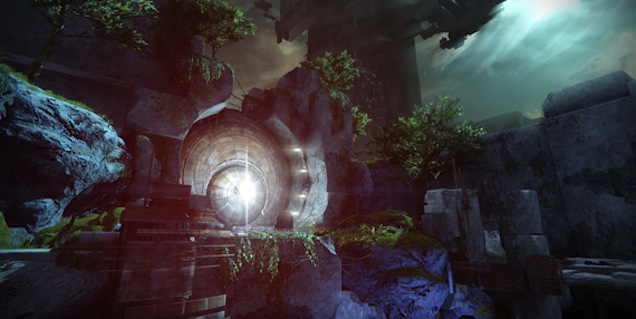
We've already gotten a sense of how the container might be filled over the months to come, and it's an immensely promising one: A week after Destiny came out, Bungie released the Vault of Glass, a free cooperative "raid" designed for six players. The Vault of Glass is fantastic. It is easily the most interesting, challenging, and rewarding thing Destiny has to offer. After playing it, I understand why it isn't more readily available to mid-level players, though I remain frustrated that the rest of the game doesn't come close to matching it.
The Vault of Glass has a laughably high bar for entry. The suggested starting level is 26, and the amount of boring repetition necessary to achieve that level should not be required of any player hoping to experience the best part of a game. The raid's other requirement, that you organize your own team of six rather than relying on built-in matchmaking, is more understandable. Unlike the more straightforward strike missions, the Vault of Glass would be unbeatable---hell, it'd be nigh un breachable---without careful teamwork and communication. A group of strangers would be stymied from the get-go, at least until there's some sort of comprehensive guide everyone can follow---but that would rob the raid of a great deal of its mysterious appeal. It's not a fair setup, and players should not be required to know and coordinate with five other equally dedicated players with the same console just to experience this stuff. But that's the way it is, at least for now.
The raid begins in the jungles of Venus, where a massive circular door stands in the side of a mountain. There is no explanation how to get the door to open, so each team must determine for themselves what to do. As it turns out, players need to simultaneously occupy three control points set across three different cliffs, fighting off waves of extremely difficult enemies for an extended period of time without letting a single point drop into enemy hands. Hold out long enough and the door will open, after which point the raid begins in earnest.
The first time our group attempted this, several of our number were lowly level 24s. We got absolutely crushed, and realized after about an hour that we stood no chance of succeeding. We returned almost a week later, higher-level and ready to try again. We were crushed once more, but we didn't give up. We spread out, adjusted our tactics, took careful stock of who was standing where. We began to aggressively communicate, to tweak our formation.
We failed and reset, failed and reset, until finally, we did it. We held the points for long enough, and the door opened.
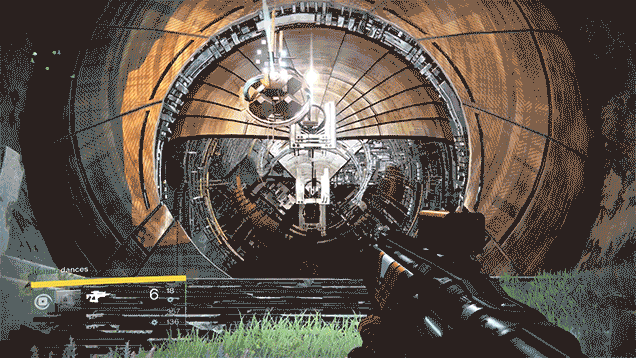
I won't spoil what followed, because figuring out how to proceed is one of the raid's great pleasures. Suffice to say, I can't remember the last time I played more than 60 hours of a game only to enter a new area that completely upended my expectations and substantially altered my view of the overall experience. The Vault of Glass has done precisely that.
Where Destiny holds the player's hand to a fault, the Vault of Glass offers absolutely no explanation of what the team should do next. Where Destiny often repeats encounters multiple times within the same mission, the Vault of Glass offers an entirely new challenge at every turn. Where Destiny talks the player's ear off with useless exposition, the Vault of Glass is silent, austere, and genuinely evocative.
But then, it's not as though the two are separate entities. Destiny contains the Vault of Glass, and the Vault of Glass is a part of Destiny. So I have to ask: If Destiny is able to turn on a dime to become this interesting and challenging, what else might it become in the future?
Every hour or two, something amazing happens at the Loot Cave. One minute, we're all standing there, shooting the aliens in the cave, business as usual. Then, out of nowhere, a handful of enemies starts attacking from a different direction. This has an effect like staring at a traffic light for two hours, only to see it turn turquoise. What the hell is going on?
In a matter of seconds, an absolute mess of monsters invades the battlefield. They're relentless and overwhelming, and they come from all sides. Our carefully coordinated firing line disperses in all directions, each of us fighting to stay alive amid the chaos. Most of the players who have been shooting into the loot cave have powerful, high-level characters, and the resulting fracas is like seeing three crossover superhero comics scanned onto a single page.
Special powers are detonating left and right, and the shadowy corners of the battlefield explode into the world's most dangerous discotheque. For the next few minutes, Destiny is at its absolute best: Six or more players, working in unison, fighting off a seemingly unstoppable force. No one speaks a word, but everyone knows what to do. They will be sorry they messed with us.
The enemies grow ever-more numerous and powerful, until it almost seems like the game is broken, or bugging out. But eventually, the battle does end. The final enemy vanishes, the final superpower is spent, and silence settles across the field. Without a word, every player lines back up in formation, aims, and begins to shoot into the cave once more.
In the space of about five minutes, Destiny has summarized itself. The pull of the slot machines may be strong, but this casino has a hell of a dance floor.
